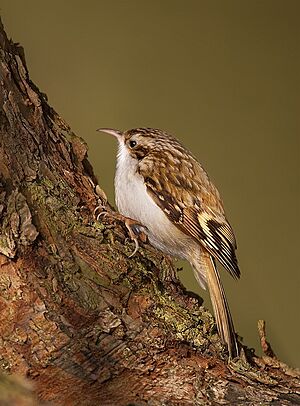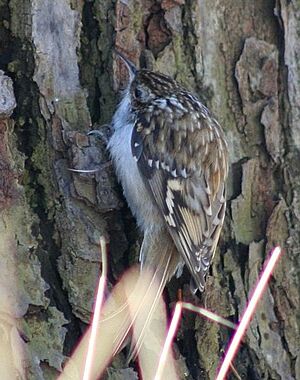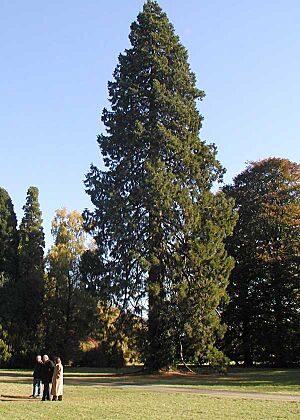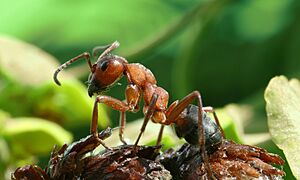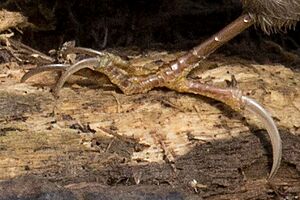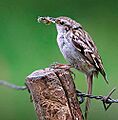Eurasian treecreeper facts for kids
Quick facts for kids Eurasian treecreeper |
|
|---|---|
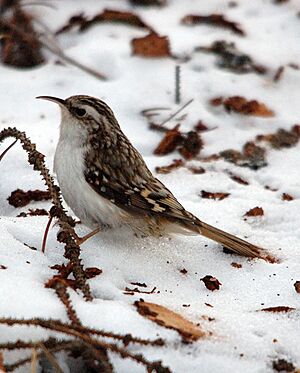 |
|
| Conservation status | |
| Scientific classification | |
| Genus: |
Certhia
|
| Species: |
familiaris
|
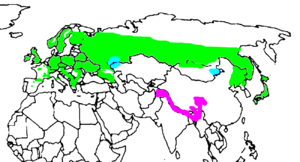 |
|
| Green – resident all year Blue – winter visitor only |
|
The Eurasian treecreeper (Certhia familiaris) is a small passerine bird found across Europe and Asia. In the British Isles, it's often just called a treecreeper. This bird looks a lot like other treecreepers. It has a curved beak, brown feathers with patterns on its back, and white feathers underneath. Its long, stiff tail feathers help it climb up tree trunks, just like a tiny mouse!
You can tell it apart from the similar short-toed treecreeper by its unique song. The Eurasian treecreeper lives in many kinds of forests. But where it shares its home with the short-toed treecreeper, it often prefers conifer forests or higher places. It builds its nest in cracks in trees or behind loose bark. It especially likes to nest in large giant sequoia trees if they are around. The female usually lays five or six white eggs with pink spots. Sadly, woodpeckers and animals like squirrels sometimes eat the eggs and chicks.
The Eurasian treecreeper loves to eat insects. It climbs up tree trunks to find them, using its thin, curved beak to pick them out of the bark. After climbing one tree, it flies to the bottom of another tree with a special wavy flight. This bird usually lives alone in winter. But when it's very cold, many treecreepers might gather together to sleep in a warm spot.
Contents
What Does It Look Like?
All treecreepers are small birds. They have brown feathers with streaks and spots on their backs. Their bottoms are a reddish-brown color, and their undersides are whitish. They have long, curved beaks. Their long, stiff tail feathers help them hold on as they creep up tree trunks looking for bugs.
The Eurasian treecreeper is about 12.5 centimeters (5 inches) long. It weighs between 7 and 13 grams (about 0.25 to 0.46 ounces). Its back is a warm brown with detailed patterns of black, buff, and white. Its tail is plain brown. The male and female birds look very similar. Young birds have duller colors on their backs than adults. Their undersides are dull white with small dark spots on their sides.
Its contact call is a very quiet, high-pitched sit. But its most special call is a clear tsree, which sounds like it vibrates. Sometimes it repeats this sound many times. The male bird's song starts with srrih, srrih. Then it adds some chirping notes, a longer sound that goes down, and a whistle that falls and then rises.
It can be tricky to tell the Eurasian treecreeper apart from other treecreepers. In Europe, it often lives in the same areas as the short-toed treecreeper. The Eurasian treecreeper has whiter undersides. Its back is warmer and has more spots. It also has a whiter stripe above its eye and a slightly shorter beak. Sometimes, it's very hard to tell them apart just by looking. But their songs are usually different. The short-toed treecreeper has a song with even notes, which sounds different from the Eurasian treecreeper's song.
Where Does It Live?
The Eurasian treecreeper is the most common treecreeper. It lives in forests across Europe and Asia, from Ireland to Japan. It likes older trees. In most parts of Europe, where it shares its home with the short-toed treecreeper, it usually lives in conifer forests, like those with spruce and fir trees.
However, in places where it's the only treecreeper, like in Russia or the British Isles, it prefers forests with broadleaf trees or mixed forests. You can also find it in parks and big gardens.
In the northern parts of its range, the Eurasian treecreeper lives at sea level. But further south, it tends to live in higher mountain areas. For example, in the Pyrenees mountains, it lives above 1,370 meters (4,500 feet).
Most Eurasian treecreepers in the warmer western and southern areas do not move far. But some birds from the north fly south for winter. Birds living in mountains might move to lower areas when it gets cold. Sometimes, these birds travel outside their usual areas. For example, some Asian treecreepers have been seen in South Korea and China.
Life and Habits
How Treecreepers Reproduce
Eurasian treecreepers start having babies when they are one year old. They build their nests in cracks in trees or behind loose bark. If there are giant sequoia trees nearby, they love to nest in them. This is because they can easily make a hollow space in the soft bark. Sometimes, they even use cracks in buildings or walls. They might also use special nest boxes made for birds in conifer forests.
The nest is made of twigs, pine needles, grass, or bark. It is lined with softer materials like feathers, wool, moss, or spider webs.
In Europe, the female usually lays five or six eggs between March and June. In Japan, they lay three to five eggs from May to July. The eggs are white with tiny pinkish spots, mostly at the wider end. Each egg is about 16 by 12 millimeters (0.63 by 0.47 inches) and weighs about 1.2 grams (0.04 ounces).
The female bird sits on the eggs for 13 to 17 days until the baby chicks hatch. The chicks are born without many feathers and need a lot of care. Both parents feed the chicks, but only the female keeps them warm. The chicks stay in the nest for another 15 to 17 days until they are ready to fly. Young birds sometimes come back to the nest for a few nights after they start flying. About 20% of pairs, especially in the south and west, will have a second group of babies.
Animals like the great spotted woodpecker, red squirrel, and small weasels sometimes attack treecreeper nests and young birds. This happens more often in forests that are broken up into smaller pieces. The more forest edge near a nest, the higher the chance of it being attacked. This is probably because there are more weasels near farm areas. The average treecreeper lives for about two years. But the oldest one ever recorded lived for eight years and ten months!
What Do Treecreepers Eat?
The Eurasian treecreeper usually looks for invertebrates (like insects and spiders) on tree trunks. It starts near the bottom of a tree and climbs upwards, using its stiff tail feathers for support. Unlike a nuthatch, it doesn't climb down trees headfirst. Instead, it flies to the bottom of another nearby tree to start climbing again. It uses its long, thin beak to pull insects and spiders out of cracks in the bark.
Even though it usually stays on trees, it sometimes hunts for food on walls, on the ground, or among fallen pine needles. In colder months, it might also eat some conifer seeds.
Female treecreepers mostly look for food on the upper parts of tree trunks. Males tend to use the lower parts. If a male bird disappears, the female will look for food at lower heights. She will also spend less time on each tree and have shorter feeding times than a female who has a partner.
Sometimes, in winter, this bird might join groups of different bird species that are feeding together. However, it doesn't seem to share the food found by the tits and goldcrests it joins. It might just benefit from having more eyes to watch out for danger. Wood ants live in the same places as treecreepers and also eat invertebrates on tree trunks. Scientists found that where these ants have been looking for food, there are fewer insects. Male treecreepers spend less time on spruce trees that have been visited by ants.
Treecreeper Habits
The Eurasian treecreeper is a small forest bird with colors that help it blend in. It also has a quiet call. Because of this, it's easy to miss as it hops up a tree trunk like a mouse. It moves in short hops, using its stiff tail and wide feet to hold on. Even so, it's not a shy bird and usually doesn't mind if humans are nearby.
It has a special wavy flight. It flaps its wings like a butterfly, then glides, sometimes tumbling a bit. Birds that are migrating might fly during the day or night. In winter, it usually lives alone. But when the weather is cold, up to a dozen or more birds will gather together to sleep in a safe, sheltered crack.
Conservation Status
The Eurasian treecreeper lives in a very large area, about 10 million square kilometers (3.8 million square miles). There are many of these birds, with an estimated 11 to 20 million just in Europe. The number of birds doesn't seem to be decreasing quickly. Because of its large population and wide range, this species is listed as Least Concern by the IUCN Red List. This means it is not considered to be in danger.
It is common in most places where it lives. But in the very northern areas, it is rare. This is because it can be hurt by very cold winters, especially if ice covers the trees and makes it hard to find food. It is also less common in Turkey and the Caucasus region. In the west of its range, it has spread to new areas like the Outer Hebrides in Scotland. It has also moved further north in Norway and first started breeding in the Netherlands in 1993.
Images for kids
-
Short-toed treecreeper, a similar bird in Europe



